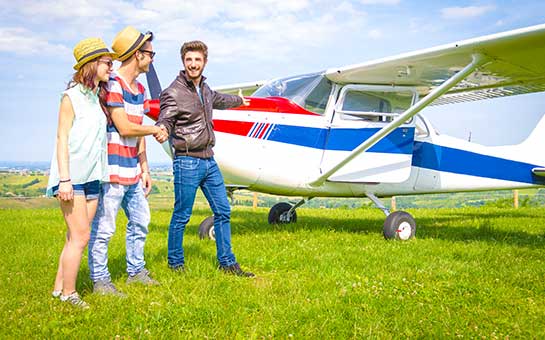Flying as a recreational activity or as a sport can be very exhilarating. While only professionals could fly an airplane some decades back, today, anyone with proper training and guidance can pilot an aircraft. Many countries in the world offer flying lessons for recreation, and you can try them during your travel.
Commercial and recreational flying have opened up new avenues, and now you can learn how to fly, just as you learn how to drive. On the other hand, you could also take a tour of the country on an airplane, a light aircraft, or even a touring helicopter. There is nothing quite like aerial views of a region to experience its true beauty.
If during your private, non-commercial flight, you experience any unexpected accidents or injuries, then flying hazardous sports travel insurance could help cover the cost of treatment.
Travel Insurance for Flying
While traveling, make sure you have flying hazardous sports travel insurance beforehand if you have plans of taking flying lessons or enjoying aerial tours of your travel destination.
Standard travel insurance plans might not cover flying as a recreational sport and might only provide coverage for flying related to domestic or international trips or for commercial purposes. Make sure you purchase the appropriate coverage, which includes recreational flying or flying lessons as well, whatever the case might be.
Spend some time researching the aircraft that you’ll be learning to pilot. If you are a novice, have a detailed conversation with your instructor about things to consider while you’re in the air.
Refrain from taking flying lessons or opting for aerial tours if you have medical issues like vertigo or high blood pressure, which might increase with high altitudes.
Choose aerial tours only from registered and licensed aerial tour providers. In the same way, take your flying lessons from a licensed instructor who has a well-maintained aircraft, parachutes, and other equipment needed for flying.
Runways and hangars are mostly situated in open grounds, a little outside the main cities. Medical facilities could be difficult to come by, and first-aid provided by the on-ground staff might not be enough for serious injuries.
In that case, you might have to be medically evacuated, which can be an expensive process. Be sure that the hazardous sports travel insurance plan you purchase includes medical evacuation benefits.
Ways You Can Enjoy Flying
You can take flying lessons in the country that you are traveling to. Many European countries, Canada, and the United States of America have licensed flying centers.
Once you get your license, you can fly light aircrafts like small airplanes and gliders. You can fly them for recreation or also use them for commercial purposes like giving aviation tours, offering deliveries in remote areas, or even rescue missions.
On the other hand, you can also enjoy aerial rides as a passenger or tourist. These rides are mostly offered in regions where there are mountains, deep forests, or ravines that can be difficult to traverse on foot. You are sure to get an entirely new perspective once you are up in the air.
Risks of Flying
Flying is sure to give you a rush of adrenaline, but it has its share of risks.
As a flying student, you could meet with accidents before you have mastered flying yourself. Although there are trainers present during flying sessions, it’s always possible to lose control of the aircraft and have an accident.
Flying accidents can also take place due to technical glitches in the aircraft. The motor might stop functioning, or there could be leakage from the fuel chamber. There have been instances of birds hitting aircraft and causing them to crash.
If you are in a flying accident, you could end up with head injuries, burns, and fractures. While there are provisions for parachute landings in case of such accidents, unfortunate instances have often been reported when the parachutes have failed to open.
With adventure sports travel insurance for flying, the insurance company can provide coverage for the medical expenses for injuries sustained during flying.
